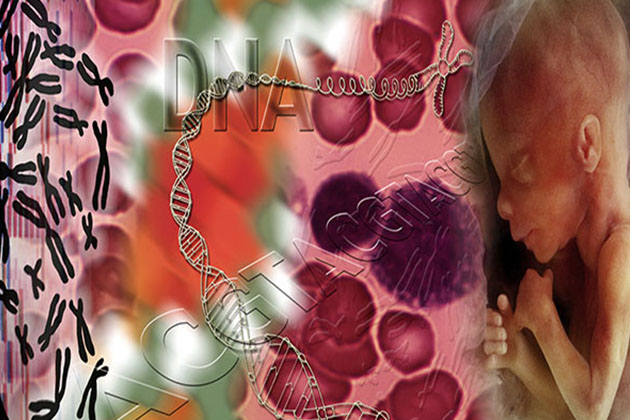Onderzoek toont veelbelovend aan voor de behandeling van genetische ziekten bij een zoogdier tijdens de ontwikkeling van de foetus in de eerste drie maanden van een zwangerschap
A genetisch stoornis is een aandoening of een ziekte die wordt veroorzaakt door abnormale veranderingen of mutaties in het DNA van een persoon in het gen. Ons DNA provides the required code for making proteins which then perform most of the functions in our body. Even if one section of our DNA gets altered in some way, the protein associated with it can no longer carry out its normal function. Depending upon where this change happens either it can have a little or no effect or it might alter the cells so much that it could then lead to a genetisch disorder or illness. Such changes are caused by errors in DNA replication (duplication) during growth, or environmental factors, lifestyle, smoking and exposure to radiation. Such disorders are passed on to the offspring and start to occur when the baby is developing in mother’s uterus and are therefore referred to as ‘birth defects’.
Birth defects can be minor or extremely severe and may affect appearance, function of an organ and some aspect of physical or mental development. Millions of children are born annually with serious genetisch conditions. These defects can be detected during pregnancy as they are evident within the first three months of pregnancy when the organs are still forming. A technique called amniocentesis is available for detecting genetisch abnormalities in the foetus by testing amniotic fluid extracted from the uterus. However, even with amniocentesis, treating them is not possible as no options are available to make any corrections before birth of the baby. Some of the defects are harmless and require no intervention but some others can be of serious nature and may require long-term treatment or even be fatal for the infant. Some defects can be corrected shortly after birth of the baby – example within a week’s time – but mostly it is too late for treatment.
Behandeling genetisch condition in an unborn baby
For the first time the revolutionary gene editing technique has been used to cure a ‘genetisch disorder’ in mice during foetal development in the uterus in a study by researchers at Carnegie Mellon University and Yale University. It is well established that during early development in the embryo (during first three months of a pregnancy) there are many stem cells (an undifferentiated cell type which can become any type of cell upon maturation) that are dividing at a fast rate. This is the pertinent time point where a genetisch mutation if corrected would reduce the impact of the mutation on embryo-to-foetal development. There are chances that a severe genetisch condition could even be cured and the baby is born without the unintended birth defects.
In deze studie gepubliceerd in Nature Communications researchers have used a peptide nucleic acid-based gene editing technique. This technique has been used before to treat beta thalassemia – a genetisch blood disorder in which haemoglobin (HB) produced in the blood is reduced considerably which then affects normal oxygen supply to various parts of the body leading to severe abnormal consequences. In this technique, unique synthetic molecules called peptide nucleic acids (PNAs) (made of a combination of synthetic protein backbone with DNA and RNA) were created. A nanoparticle was then used to transport these PNA molecules along with “healthy and normal” donor DNA to the location of a genetisch mutation. The complex of PNA and DNA identifies the designated mutation at a site, PNA molecule then binds and unzips the double helix of mutated or faulty DNA. Lastly, donor DNA binds with the mutated DNA and automates a mechanism to correct the DNA error. The main significance of this study is that it was done in a foetus, thus researchers had to use a method analogous to amniocentesis wherein they inserted the PNA complex into the amniotic sac (amniotic fluid) of pregnant mice whose foetuses were carrying the gen mutatie die bèta-thalassemie veroorzaakt. Na één injectie met PNA werd 6 procent van de mutaties gecorrigeerd. Deze muizen vertoonden een verbetering van de symptomen van de ziekte, dwz de hemoglobinespiegels waren in het normale bereik, wat kan worden geïnterpreteerd als de muizen die 'genezen' waren van de aandoening. Ze vertoonden ook een verhoogde overlevingskans. Deze injectie was in een zeer beperkt bereik, maar onderzoekers hopen dat nog hogere succespercentages kunnen worden bereikt als injecties meerdere keren worden gedaan.
Het onderzoek is relevant omdat er geen off-targets zijn geconstateerd en alleen het gewenste DNA is gecorrigeerd. Genbewerkingstechnieken zoals CRISPR/Cas9 zijn weliswaar gemakkelijker te gebruiken voor onderzoeksdoeleinden, maar het is nog steeds controversieel omdat het het DNA doorsnijdt en off-site fouten uitvoert, aangezien ze ook een off-target normaal DNA beschadigen. Vanwege deze beperking zijn ze niet bij uitstek geschikt voor het ontwerpen van therapieën. Gezien deze factor bindt de methode die in het huidige onderzoek wordt getoond alleen aan het doel-DNA en herstelt het en vertoont het geen offsite-fouten. Deze gerichte kwaliteit maakt het ideaal voor therapieën. Een dergelijke methode in het huidige ontwerp zou in de toekomst mogelijk ook kunnen worden gebruikt om andere aandoeningen te 'genezen'.
***
{U kunt de originele onderzoekspaper lezen door op de DOI-link hieronder in de lijst met geciteerde bron(nen) te klikken}
Bron (nen)
Ricciardi AS et al. 2018. In utero levering van nanodeeltjes voor site-specifieke genoombewerking. Nature Communications. https://doi.org/10.1038/s41467-018-04894-2
***






































